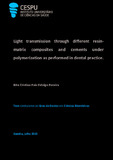Light transmission through different resin-matrix composites and cements under polymerization as performed in dental practice
Resumen
Purpose: The purpose of present thesis was to evaluate the light transmittance through traditional and flowable resin-matrix composites containing different amount of inorganic fillers as well as the light transmittance through resin-matrix onlays cemented with resin cements and flowable resin-matrix composites.
Materials and methods: At first, resin-matrix composites disc-shaped specimens with 10 mm diameter and 2 mm thickness were prepared on glass molds. Three traditional resin-matrix composites contained inorganic fillers at 74, 78-80, and 89 wt. % while two flowable resin-matrix composites revealed 60 and 62.5 wt. % of inorganic fillers. Also, 2 specimens of resin-matrix composite blocks for CAD/CAM were cross-sectioned with 2- or 3-mm thickness and then conditioned with adhesive system. Specimens were divided in onlay groups according to the luting material, namely: two dual-cured resin cements (73 and 78 wt. % inorganic fillers), two flowable resin-matrix composites (83 and 60 wt. % inorganic particles), and one thermal-induced flowable resin-matrix composite (83 wt. % of inorganic particles). Resin composites were light-cured for 10, 20, or 40 s while onlay-luting material specimens were light-cured for 40s. Specimens were inspected by optical microscopy and scanning electron microscopy followed by micro- and nano-scale indentation tests. Optical transmittance assays were preformed using a spectrophotometer with an integrated monochromator before and after light-curing.
Results: On resin-matrix composites,the lowest optical transmittance was recorded for the resin-matrix composite reinforced with 89 wt. % inorganic fillers, while the highest optical transmittance was recorded for the resin-matrix composite reinforced with 60 wt. % of inorganic fillers. Micro-scale particles were observed with variable sizes and shape although the chemical composition was validated as given by the manufacturers. The highest mean values of elastic modulus, nanohardness and microhardness were recorded for the resin-matrix composites with 89 wt. % of inorganic content. Regarding the optical transmittance through resin-matrix composites onlays with 2 mm-thickness, the highest values of light transmittance were recorded for specimens cemented with flowable resin-matrix with 60 wt. %inorganic fillers. On 3 mm thickness onlays, the highest values of light transmittance were recorded for specimens cemented with flowable resin-matrix composite reinforced with 83 wt. % inorganic fillers. The lowest optical transmittance
was recorded for resin-matrix cement reinforced with 78 wt. % for both 2- or 3-mm thickness.
Conclusions: A high content of 89 wt. % of inorganic fillers decreased the light transmittance through resin-matrix composite. On onlays the optical transmittance highly decreases when onlays thickness increases. Also, the materials’ microstructure highly affects the optical transmittance through the onlays and luting materials. The type, size, and content of inorganic fillers of the luting material affected the thickness of the cement layer and light transmittance through the materials. However, certain types of fillers, due to low refraction index do not interfere the light transmission maintaining an optimal polymerization and the physical properties of the resin-matrix composites.

